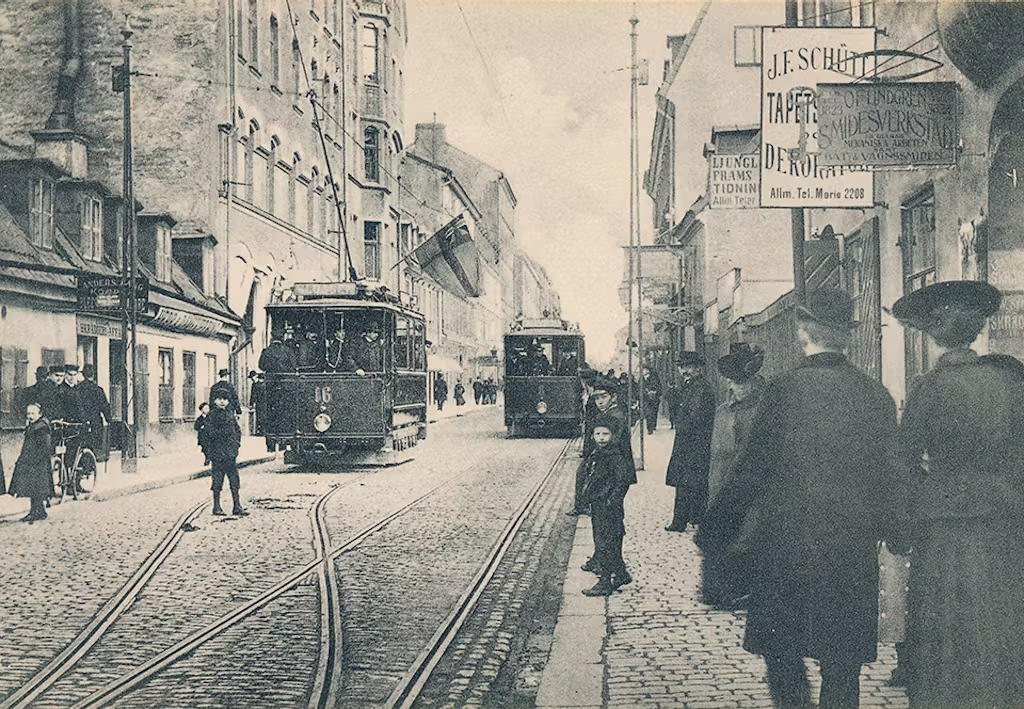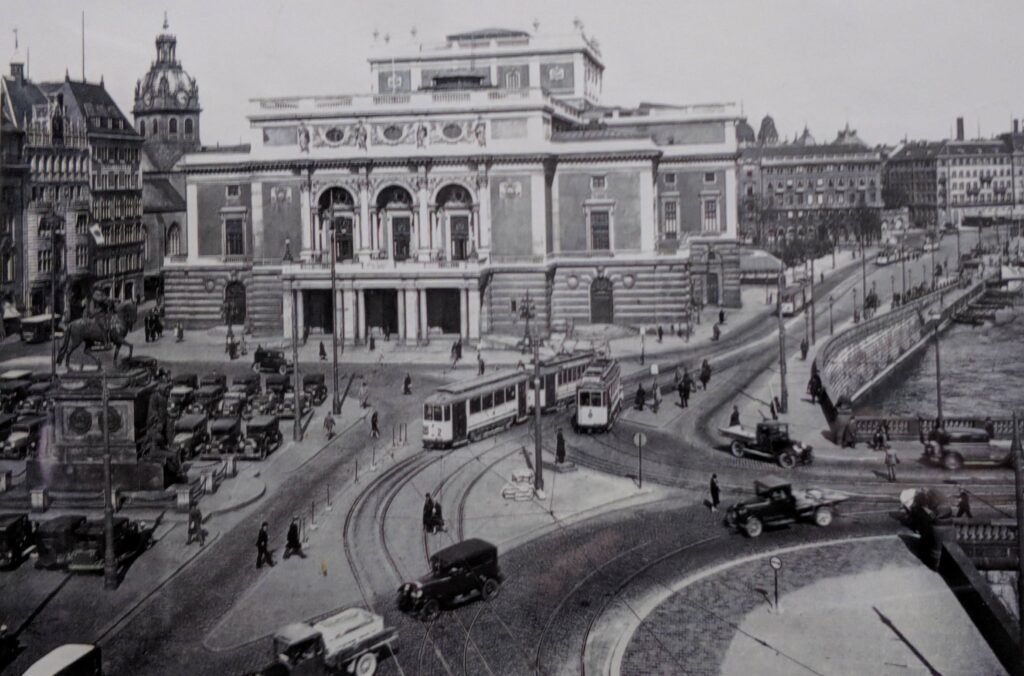Stockholm Then and Now
Stockholm Then
Stockholm, the capital and largest city of Sweden, is renowned for its stunning geographical setting, nestled at the junction of Lake Mälaren and Salt Bay, which connects to the Baltic Sea.
The city is uniquely spread across 14 islands, creating a picturesque blend of water and urban landscape.
The surrounding waters and lush greenery complement its vibrant urban life, offering a harmonious balance between nature and city development.
The city’s location, between the Gulf of Finland and the Baltic, not only enhances its natural beauty but also makes Stockholm a significant hub for trade, culture, and history in Scandinavia.
This combination of natural landscapes and modern architecture has earned Stockholm a reputation as one of the most beautiful capital cities in the world.

Stockholm History
Stockholm’s history dates back to the Viking Age, when it is believed to have been referred to as Agnafit in the Norse sagas, and later mentioned in Heimskringla in connection with the legendary King Agne.
During this period, Birka, a nearby settlement, was one of Sweden’s major trade centers.
The earliest written mention of the name “Stockholm” appeared in 1252, signaling the city’s growing importance in the iron trade, particularly due to the mineral-rich Bergslagen region.
Related Article: Moscow Then and Now
The name itself is derived from Swedish words: “stock,” meaning log (possibly linked to an old German word for fortification), and “holm,” meaning islet, likely referring to Helgeandsholmen, an islet in central Stockholm.
The city’s core, Gamla Stan (Old Town), began to take shape on the central island by the mid-13th century.
It rose to prominence as part of the Hanseatic League’s Baltic trade routes, forming strong economic and cultural ties with key cities like Lübeck, Hamburg, and Gdańsk.
This strategic location on the water also made Stockholm vital in the political conflicts of the 15th and 16th centuries.
Related Article: Warsaw Then and Now
In 1520, the city witnessed the infamous Stockholm Bloodbath, where King Christian II of Denmark ordered the execution of opposition leaders, sparking uprisings that ultimately led to Sweden’s independence under King Gustav Vasa in 1523.
The 17th century marked a period of significant growth as Sweden expanded into a major European power.
Stockholm became the capital of the Swedish Empire in 1634, with a rapidly growing population and booming economy.
This era also saw significant urban development, including the construction of Stockholm Palace after the Tre Kronor Castle burned down in 1697.
Related Article: Budapest Then and Now

During the reign of Queen Christina, the city became a hub of culture and science, attracting intellectuals and artists like René Descartes and Christopher Polhem.
However, Stockholm faced hardships in the 18th century, including the devastating plague of 1710 that wiped out a third of the population.
Despite this, the city maintained its political and cultural significance in Sweden.
Under King Gustav III in the late 18th century, the city flourished once again, especially in the arts and sciences.
Related Article: Prague Then and Now
Figures like Carl Michael Bellman and Joseph Martin Kraus enriched Stockholm’s music scene, while scientific minds such as Carl Linnaeus and Anders Celsius advanced research in the city.
The 19th century saw Stockholm transition through economic decline, followed by a resurgence as the city industrialized.
With this industrialization, Stockholm’s population grew rapidly, fueled by migration from rural areas, and new industries emerged, establishing the city as a key trade and service hub.
The establishment of major scientific institutions, like the Karolinska Institutet and the Royal Institute of Technology, further bolstered Stockholm’s position as an intellectual center.
Related Article: Vienna Then and Now
The 20th century brought modernization and significant urban development, though it also sparked controversy, particularly as large parts of the historical district of Klara were demolished to make way for modernist architecture.
Despite this, many historical areas like Gamla Stan and Södermalm remained preserved.
As Stockholm became increasingly ethnically diverse, it transformed into a modern, high-tech city.
Today, the city continues to evolve with its growing population and economy, maintaining a delicate balance between historical preservation and modern growth.
Related Article: Athens Then and Now
Stockholm Now

Stockholm, the capital and largest city of Sweden serves as the political, economic, and cultural heart of the country.
With a population of about 1 million in the city itself and over 2.4 million in the metropolitan area, it is the largest urban area in the Nordic region.
The city is famously built on fourteen islands where Lake Mälaren meets the Baltic Sea, forming a stunning landscape that blends natural beauty with modern urbanization.
Related Article: Rome Then and Now
Stockholm’s location is not only picturesque but also historically strategic, with its proximity to the Baltic region playing a crucial role in Sweden’s early development as a trading power.
Today, Stockholm stands as Sweden’s primary financial center and one of the largest in Scandinavia.
Its role in global finance is bolstered by the presence of major Swedish companies and the headquarters of the country’s largest banks.
Related Article: Barcelona Then and Now
The city is also a thriving tech hub, sometimes referred to as Europe’s innovation hub, owing to its vibrant start-up scene and robust economy.
With a GDP of around $180 billion, Stockholm contributes significantly to Sweden’s national economy, and its residents enjoy the highest GDP per capita of any county in the country.
The city’s geography plays a major role in its identity. Situated on the 59th parallel north, Stockholm enjoys a temperate climate similar to parts of northeastern North America.
Related Article: Amsterdam Then and Now
Its unique positioning between the freshwater Lake Mälaren and the Baltic Sea gives it both scenic beauty and strategic importance.
Over 30% of the city is made up of waterways, and another 30% is covered by parks and green spaces, making Stockholm one of the greenest capitals in Europe.
This natural landscape, coupled with a carefully planned urban structure, contributes to Stockholm’s high quality of life and its appeal as a tourist destination.
Related Article: Berlin Then and Now
Stockholm is also the seat of Sweden’s government, hosting the Swedish parliament (Riksdag) in the Parliament House and the official residences of the monarch and the Prime Minister.
The royal family’s official residence, Stockholm Palace, is located in the heart of the city, while Drottningholm Palace, situated just outside the city, serves as the family’s private residence.
The city is also home to several world-renowned institutions, including the Nobel Prizes, which further cement its status as a global center for culture and innovation.
Related Article: Paris Then and Now
In addition to its political and economic significance, Stockholm is a cultural capital, offering a wealth of museums, galleries, and theaters.
It has long been a center for Swedish art, literature, and music, with figures like Carl Michael Bellman and Carl Linnaeus contributing to the city’s artistic and scientific heritage.
Today, Stockholm continues to attract people from around the world, drawn by its combination of history, culture, innovation, and stunning natural surroundings.
Related Article: London Then and Now
FAQs
Stockholm is famous for its beautiful archipelago, historic sites like the Royal Palace and Gamla Stan (Old Town), its innovation in technology, and being a cultural hub with world-class museums like the Vasa Museum and ABBA The Museum.
Stockholm is renowned for its role as Sweden’s capital, a global leader in technology and sustainability, and its rich history.
It’s also known for its scenic waterways, vibrant design scene, and being home to the Nobel Prize ceremonies.
Stockholm is generally considered an expensive city, with high costs for accommodation, dining, and entertainment compared to many other cities in Europe. However, it offers a high quality of life with excellent public services.
Yes, Stockholm is often regarded as a romantic city due to its picturesque canals, charming old town, and beautiful parks.
The city’s serene atmosphere, especially during sunset, makes it a popular destination for couples.






























